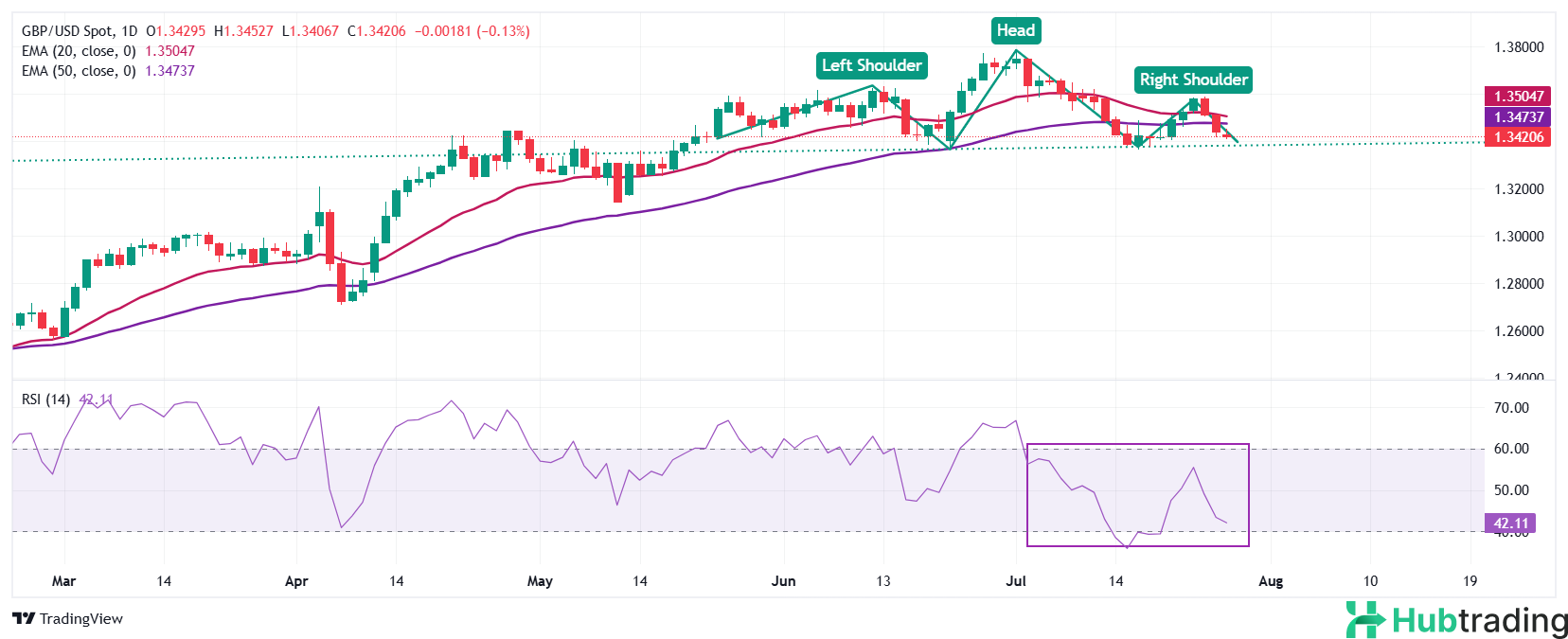-
The Pound Sterling declines toward 1.3400 against the US Dollar following the US-EU trade agreement.
-
Markets anticipate the Federal Reserve will hold interest rates steady in Wednesday’s policy decision.
-
The Bank of England is widely expected to implement a rate cut next week.
The Pound Sterling (GBP) declines toward 1.3400 against the US Dollar (USD) during Monday’s European trading session, pressured by renewed demand for the Greenback following the announcement of a trade framework between the United States (US) and the European Union (EU).
The US Dollar Index (DXY), which measures the currency’s strength against a basket of six major rivals, climbs to around 97.90 at the time of writing, reflecting growing investor appetite for the USD.
Over the weekend, US President Donald Trump confirmed a new trade agreement with the EU, setting a baseline tariff of 15% on European imports—down from the previously threatened 30%. The deal has not only reduced uncertainty ahead of the August 1 tariff deadline but also improved the overall outlook for the US economy, prompting a surge in demand for riskier assets.
Despite the broader risk-on sentiment, risk-sensitive currencies like the Pound have struggled to gain traction, as the trade pact has reinforced bullish sentiment toward the US Dollar.
The confirmation of the US-EU trade deal marks another step in Washington’s ongoing efforts to resolve trade tensions with key global partners, leaving only Canada and Mexico without finalized agreements.
Meanwhile, market participants are closely watching upcoming US-China trade talks in Stockholm, which are set to begin Monday. According to the South China Morning Post (SCMP), both sides are expected to extend the current tariff truce for another 90 days, pushing the expiration to August 12 and potentially offering more clarity to global markets.
Daily Digest Market Movers: Pound Sterling Shows Mixed Signals Amid BoE Rate Cut Bets
- The Pound Sterling delivered a mixed performance against its major peers during Monday’s European trading session, with sentiment shaped largely by speculation surrounding the Bank of England’s (BoE) upcoming monetary policy decision. A light UK economic calendar has shifted focus entirely toward the August 7 BoE meeting, where traders have fully priced in a 25 basis point (bps) rate cut.
- Expectations for a rate reduction have strengthened amid signs of a cooling labor market. Recent employment data revealed a slowdown in hiring, attributed in part to increased employer contributions to National Insurance (NI), which rose from 13.8% to 15% following Chancellor Rachel Reeves’ Autumn Statement.
- Supporting this narrative, last week’s preliminary UK S&P Global Purchasing Managers’ Index (PMI) for July showed the sharpest decline in staffing levels since February, further stoking concerns over weakening labor conditions.
- Globally, attention turns to the Federal Reserve’s monetary policy decision on Wednesday. According to the CME FedWatch Tool, the Fed is expected to hold interest rates steady at the 4.25%–4.50% range. While no policy shift is anticipated, markets will closely scrutinize Fed Chair Jerome Powell’s post-meeting remarks for insight into the inflationary impact of tariffs and potential rate actions later this year.
Technical Analysis: GBP/USD Pressured Below Key Moving Averages
The Pound Sterling extended losses against the US Dollar on Monday, dipping toward the 1.3400 level as the near-term technical outlook remains bearish. The GBP/USD pair is now trading below both the 20-day and 50-day Exponential Moving Averages (EMAs), located at 1.3505 and 1.3474 respectively—highlighting mounting downside pressure.
Adding to the bearish setup, a Head and Shoulders (H&S) pattern has formed on the daily chart, with the neckline positioned near 1.3413. A break and close below this level could confirm a deeper corrective phase for the pair.
Momentum indicators reinforce the downtrend, with the 14-day Relative Strength Index (RSI) sliding toward the 40.00 mark. A sustained move below this level could trigger further selling pressure.
On the downside, the next major support lies at the May 12 low of 1.3140. To the upside, any recovery will likely face strong resistance at the July 1 high around 1.3790—a key hurdle for bulls to reclaim directional control.






